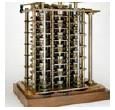Olympiad Test: Evolution Of Computer - Class 4 MCQ
20 Questions MCQ Test Cyber Olympiad Class 4 - Olympiad Test: Evolution Of Computer
A special electronic machine that accepts instructions, processes the information and puts out the information is called ______.
Which computer amongst the following will be the fastest?
| 1 Crore+ students have signed up on EduRev. Have you? Download the App |
Speed of a processor is measured in which of the following units?
Which of the following is NOT an example of fourth generation computer?
Napier’s Bones is so named because it was invented by ______.
Which of the following determines the power of a computer?
The ‘Abacus’ is derived from the greek word called ______.
This device which was made up of movable wheels is called ______.

Which of the following calculating devices was invented by Sir John Napier?
The first mechanical calculator invented by Sir Blaise Pascal was known as ______.
Which of the following was also knownas the first general purpose mechanical computer?
This was the first electronic computer that used the concept of a stored program. It was called the ______.
How is a generation of computers classified?
MARK-I was the first electro-mechanical computer. It was invented by ______.
This was the first electronic general purpose computer conceived and designed by John Mauchly and J.presper Eckert. It was called the ______.
Which of the following PCs has a touchpad as an input device?
This image displays the CRAY 1. CRAY 1 is a ______.

______ and ______ are supercomputers made in India.
|
7 videos|1 docs|32 tests
|


















